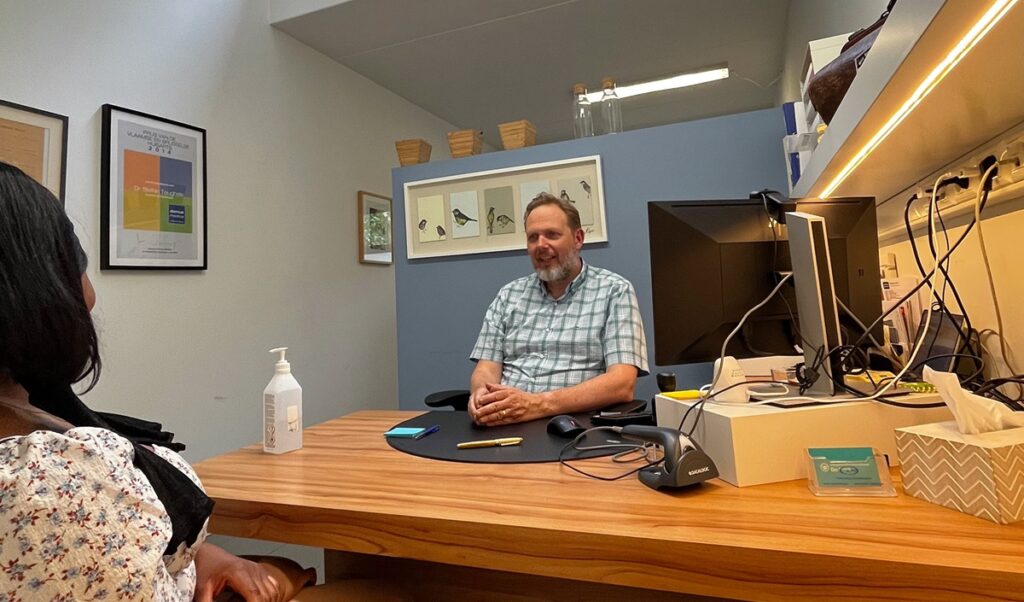Just a few years in the past, throughout a 3-week vacation, Dr Stefan Teughels had time to replicate on his demanding work as a normal practitioner and chairperson of normal observe organizations in Belgium. By the tip of his break, he had determined to stop his job as a normal practitioner. “On the Monday, I began my observe and inside one hour of affected person contact, I had modified my thoughts,” he remembers. “The shut relationship with sufferers, even a private reference to some… it’s such a novel privilege, I wouldn’t need to miss it.”
A day within the lifetime of a normal practitioner in Flanders
Stefan graduated as a normal practitioner in 1996. He’s presently working in a multidisciplinary major care facility in Flanders the place normal observe, nursing, midwifery, occupational well being, psychology, social work and physiotherapy professionals work intently collectively to supply holistic, people-centred care. The clinic is in a small city of about 30 000 individuals, with a historic centre and flanked by waterways and forests. But managing such a clinic is way from a stroll within the park.
Stefan paints the image of an ageing inhabitants with more and more prevalent noncommunicable ailments and psychological well being situations, together with stress and burnout. The present well being care system doesn’t at all times meet individuals’s well being wants, particularly as it’s concentrated in giant cities, with clinics in regional and rural areas like his being the exception.
Multidisciplinary and built-in major care, environment friendly triage and task-sharing, and well being promotion and prevention are but to develop into a actuality in most normal practices in Flanders. An optimist at coronary heart, Stefan believes that normal practitioners can rise to the numerous challenges and ship high quality and cost-effective major care, if insurance policies give them the chance to take action.
For him, this contains fee mechanisms in addition to well being info techniques that favour built-in and holistic care, together with the prevention, early detection and administration of ear and listening to situations.
Addressing listening to loss in major care
Stefan goals of a future the place normal practitioners have the means to proactively tackle ear and listening to situations.
He balances the reluctance of individuals to acknowledge listening to loss, given the stigma connected to the situation, with the significance of excellent listening to to keep away from social isolation, and thereby to advertise wholesome ageing. He has a listening to screening gadget for when individuals suspect listening to points and provides {that a} listening to test ought to be a part of the package deal of exams when cognitive decline is being investigated.
Moreover, nurses on the clinic can simply flush out extreme wax in sufferers’ ears. “A lot of the sufferers with listening to loss I see can hear me in my quiet workplace,” he explains. “To make sure good communication regardless of listening to loss, I’ll typically write or draw, or contain a member of the family.”
He remembers a child recognized with listening to loss via common new child listening to screening. “The specialised care from the college hospital, together with bilateral cochlear implantation and aftercare, has been wonderful. As a normal practitioner near the household, my distinctive position has been to supply them with the psychosocial assist they wanted and the solutions to the health-related questions they’d as they went via this adjustment course of.”
Communication is on the coronary heart of environment friendly and person-centred major care. “I name it the triangle of communication; the affected person, the final practitioner and the specialist should communicate the identical language for care to be really environment friendly and holistic,” he says.
WHO/Europe assist
Ear and listening to situations are among the many commonest well being issues. Within the WHO European Area alone, roughly 190 million individuals have listening to loss or deafness. WHO/Europe continues to assist international locations as they combine people-centred ear and listening to care inside nationwide well being techniques.
Over 60% of ear and listening to situations will be recognized and addressed in major care. Help offered by WHO/Europe contains the mixing of ear and listening to care inside major well being care and the implementation of the WHO “Main ear and listening to care: coaching handbook” and associated assets.
Profitable integration of ear and listening to care requires a robust and resilient major health-care sector, together with its workforce. Within the report “Well being and care workforce in Europe: time to behave”, WHO/Europe calls on Member States to implement 10 actions to strengthen the well being workforce, together with increasing using digital instruments that assist the workforce, creating methods that entice and retain well being employees in rural and distant areas, creating working situations that promote a wholesome work-life steadiness, defending the well being and psychological well-being of the workforce, and optimizing using funds via modern workforce insurance policies.


